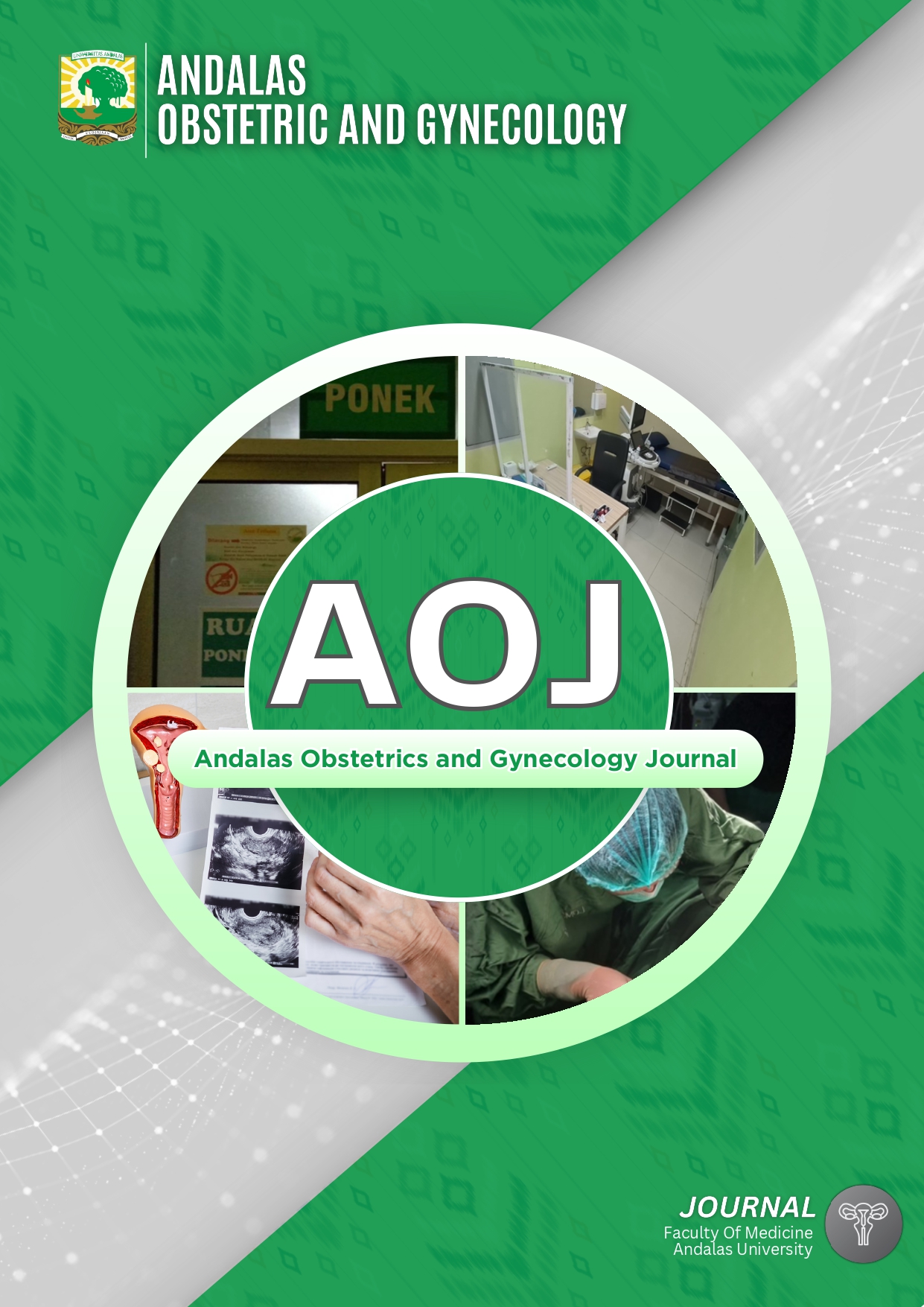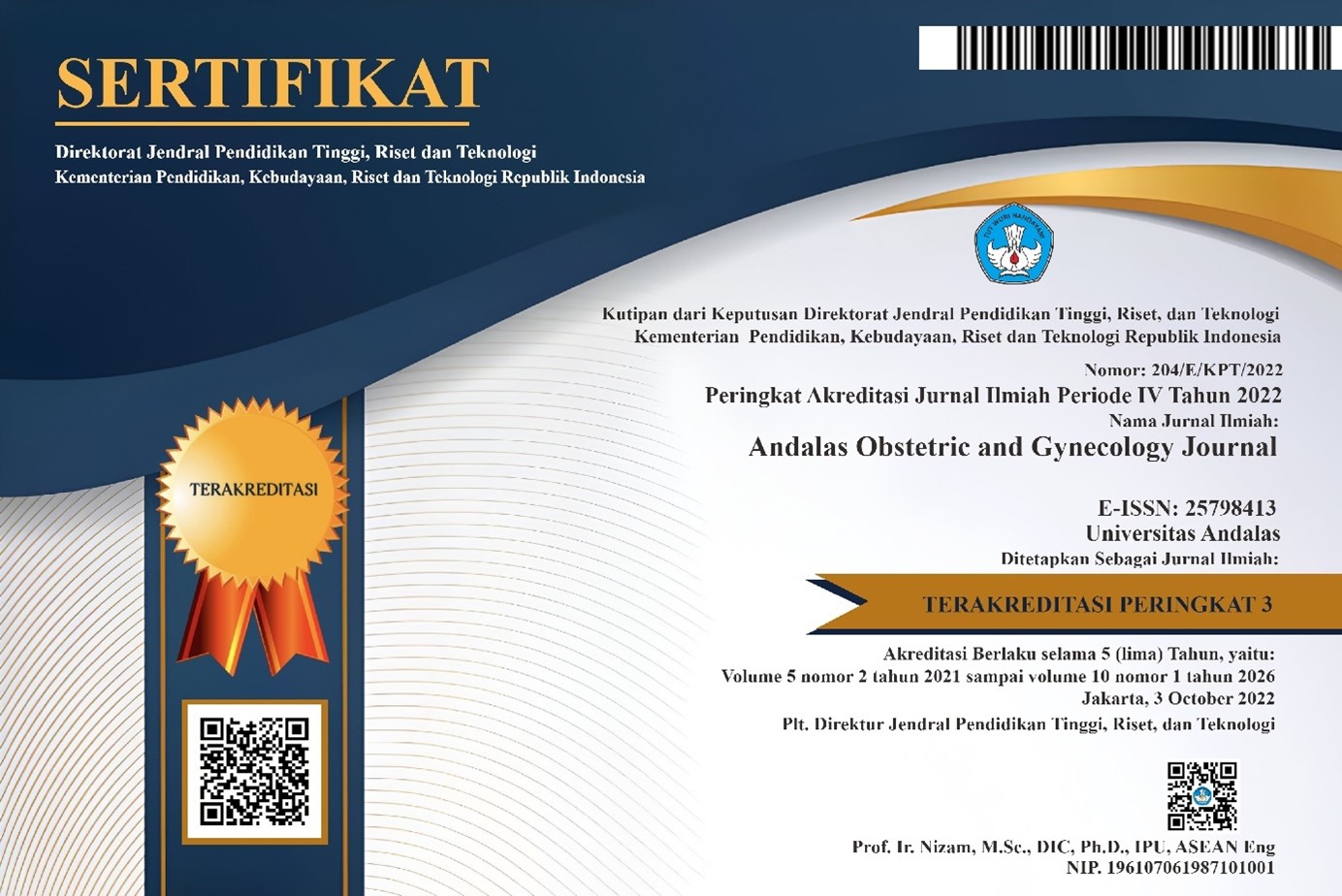Correlation of Neutrophil Lymphocyte Ration (NLR) Values with Severe Preeclampsia, HELLP Syndrome and Eclampsia
DOI:
https://doi.org/10.25077/aoj.7.2.379-390.2023Keywords:
Neutrophil-lymphocyte ratio (NLR), preeclampsia, HELLP syndrome, eclampsiaAbstract
Background:  Preeclampsia (PE) is the leading cause of maternal and fetal morbidity and mortality. The disease is characterized by hypertension (≥140/90 mmHg), proteinuria, thrombocytopenia, renal failure, neurological complications, liver involvement, and fetal growth retardation. HELLP syndrome is a variant of preeclampsia that causes an increase in liver enzymes and a low platelet count. Eclampsia is the heaviest complication of preeclampsia. Neutrophil lymphocyte ratio (NLR) is part of the leukocyte type count examination which is an easy, available examination parameter and can be used as an index of the severity of systemic inflammation. This study aimed to determine the relationship of neutrophil-lymphocyte ratio (NLR) values with severe Preeclampsia, HELLP syndrome, and eclampsia.
Method: This research is a comparative analytical study with a case control study approach. This research was conducted from April-November 2022. This study was conducted at the emergency room (ER) and inpatient department of Obstetrics and Gynecology, Faculty of Medicine, Universitas Andalas – RSUP Dr. M. Djamil Padang. The study sample was part of the population that met the inclusion and exclusion criteria. The study required 108 samples, namely 27 from the severe preeclampsia group, 27 from the eclampsia group, 27 from the HELLP syndrome group, and 27 from the control group. Bivariate statistical analysis using Independent T-Test. Samples were taken by the method of consecutive sampling. The data were analyzed at a 95% confidence interval, if obtained p value<0.05 then there is a significant relationship. The Data was analyzed by the SPSS computer program.
Results: The results of this study obtained neutrophil-lymphocyte ratio in eclampsia has the highest average value compared with HELLP syndrome, severe preeclampsia, and control. While HELLP syndrome has a higher mean value than severe preeclampsia and control and subsequently severe preeclampsia also has a higher mean value NLR than control. This study found a significant relationship between neutrophil-lymphocyte ratio (NLR) with severe Preeclampsia, HELLP syndrome, and eclampsia (all p values=0.000).
Conclusion: This study proves that neutrophil-lymphocyte ratio (NLR) has a significant relationship with severe Preeclampsia, HELLP syndrome, and eclampsia so further research can develop this study by analyzing other factors that affect preeclampsia. For clinicians can make this study as a reference in monitoring the progression of inflammation that occurs in severe preeclampsia, HELLP syndrome, and eclampsia.
References
Rana S, Burke SD, Karumanchi SA. Imbalances in Circulating Angiogenic Factors in the Pathophysiology of Preeclampsia and Related Disorders. Am J Obstet Gynecol. 2020;1:1–16.
RodrÃguez KBM, Gómez LMR, Yáñez LC, RamÃrez RF, Ornelas-Rebolledo O, Borjas-GarcÃa JA, et al. Application of the electronic nose in predicting preeclampsia in high-risk pregnancies. Pilot study. Arch Med Res. 2021;(xxxx):8–15.
Wang W, Xie X, Yuan T, Wang Y, Zhao F, Zhou Z, et al. Epidemiological trends of maternal hypertensive disorders of pregnancy at the global, regional, and national levels: a populationâ€based study. BMC Pregnancy Childbirth. 2021 Dec 1;21(1).
Shahd A. Karrar; Peter L. Hong. Preeclampsia. StatPearls. Treasure Island (FL): StatPearls Publishing; 2022 Jan. 2022 Jun 9. PMID: 34033373 Bookshelf ID: NBK570611.
Putra IR, Basyir V. Karakteristik Ibu Hamil dan Berat Badan Lahir Bayi pada Kejadian Preeklampsia di Rsup Dr. M. Djamil Padang Tahun 2020- 2021. 2022;7(12).
Wang W, Xie X, Yuan T, Wang Y, Zhao F, Zhou Z, et al. Epidemiological trends of maternal hypertensive disorders of pregnancy at the global, regional, and national levels: a population-based study. BMC Pregnancy Childbirth. 2021 Dec 1;21(1).
Sisti G, Faraci A, Silva J, Upadhyay R. Neutrophil-to-lymphocyte ratio, platelet-to-lymphocyte ratio and complete blood count components in the first trimester do not predict hellp syndrome. Medicina (Lithuania). 2019;55(6):8–12.
Jadli A, Ghosh K, Damania K, Satoskar P, Bansal V, Shetty S. Prediction of preeclampsia using combination of biomarkers at 18–23 weeks of gestation: A nested case-control study. Pregnancy Hypertens. 2019;17(February):20–7.
Widihastuti Y. NLR DAN ALC UNTUK DIAGNOSIS COVID-19 [Internet]. BKKPM. 2020 [cited 2021 Mar 28]. Available from: http://www.bbkpm-bandung.org/blog/2020/05/rnacovid
Aslan MM, Yeler MT, Yuvacı HU, Cerci IA, Cevrioğlu AS, Ozden S. Can the neutrophil-to-lymphocyte ratio (NLR) predicts fetal loss in preeclampsia with severe features? Pregnancy Hypertens. 2020;22(July):14–6.
Wang J, Zhu QW, Cheng XY, Liu J yue, Zhang L li, Tao YM, et al. Assessment efficacy of neutrophil-lymphocyte ratio and monocyte-lymphocyte ratio in preeclampsia. J Reprod Immunol. 2019;132(December 2018):29–34.
Serra B, Mendoza M, Scazzocchio E, Meler E, Nolla M, Sabrià E, et al. A new model for screening for early-onset preeclampsia. Am J Obstet Gynecol. 2020;222(6):608.e1-608.e18.
Grum T, Seifu A, Abay M, Angesom T, Tsegay L. Determinants of pre- eclampsia/Eclampsia among women attending delivery Services in Selected Public Hospitals of Addis Ababa, Ethiopia: A case control study. BMC Pregnancy Childbirth. 2017;17(1):1–7.
Kumari N, Dash K, Singh R. Relationship between Maternal Age and Preeclampsia. IOSR Journal of Dental and Medical Sciences (IOSR-JDMS) e-ISSN. 2016;15(12):55–7.
Aulia D, Islamy N, Yonata A. Hipertensi Kronis Superimposed Preeklampsia dengan Impending Eklampsia dan Partial HELLP Syndrome Chronic Hypertension Superimposed Preeclampsia with Impending Eclampsia and Partial HELLP Syndrome. Medula. 2020;10:359–64.
Sisti G, Faraci A, Silva J, Upadhyay R. Neutrophil-to-lymphocyte ratio, platelet-to-lymphocyte ratio and complete blood count components in the first trimester do not predict hellp syndrome. Medicina (Lithuania). 2019;55(6):8–12.
Sachan R, Patel M, Vandana, Sachan P, Shyam R. Diagnostic accuracy of neutrophil to lymphocyte ratio in prediction of nonsevere preeclampsia and severe preeclampsia. Journal of Current Research in Scientific Medicine. 2017;3(2):79.
Gogoi P, Sinha P, Gupta B, Firmal P, Rajaram S. Neutrophil-to-lymphocyte ratio and platelet indices in pre-eclampsia. International Journal of Gynecology and Obstetrics. 2019;144(1):16–20.
Yavuzcan A, Çaǧlar M, Üstün Y, Dilbaz S, Özdemir I, Yildiz E, et al. Mean platelet volume, neutrophil-lymphocyte ratio and platelet-lymphocyte ratio in severe preeclampsia. Ginekol Pol. 2014;85(3):197–203.
Oğlak SC, Tunç Ş, Ölmez F. First Trimester Mean Platelet Volume, Neutrophil to Lymphocyte Ratio, and Platelet to Lymphocyte Ratio Values Are Useful Markers for Predicting Preeclampsia. Ochsner Journal. 2021;21(4):364–70.
Bayram F, KaraÅŸin SS. The predictive role of neutrophil-lymphocyte ratio, platelet lymphocyte ratio, and other complete blood count parameters in eclampsia and HELLP syndrome. Journal of Surgery and Medicine. 2021;5(12):1202-1205.
M. Banda J, O. P. Musa B, C. Onyemelukwe G, O. Shittu S, A. Babadoko A, G. Bakari A, et al. T Lymphocyte Subpopulations in Normal Pregnancies and Those Complicated by Eclampsia in Kaduna State, Nigeria. Open J Immunol. 2016;06(03):93–100.
Kholeif AE, Khamis MY, Eltabakh S, Swilam RS, Elhabashy A, EISherif R. Prediction of severity of preeclampsia in Egyptian patients: Role of neutrophil/lymphocyte ratio, platelet/lymphocyte ratio and C-reactive protein. Clin Exp Obstet Gynecol. 2020;47(2):183–8.
Kholief A, Swilam R, Elhabashy A, Elsherief R. Neutrophil/lymphocyte ratio, platelet/lymphocyte ratio, and c-reactive protein as markers for severity of pre-eclampsia. Research and Opinion in Anesthesia and Intensive Care. 2019;6(1):1.
Kurtoglu E, Kokcu A, Celik H, Tosun M, Malatyalioglu E. May ratio of neutrophil to lymphocyte be useful in predicting the risk of developing preeclampsia? A pilot study. Journal of Maternal-Fetal and Neonatal Medicine. 2015;28(1):97–9
Downloads
Published
Issue
Section
License
Copyright (c) 2023 Indah Lisfi, Roza Sriyanti, Firdawati FIrdawati

This work is licensed under a Creative Commons Attribution 4.0 International License.
Copyright
Authors who publish with this journal agree to the following terms:
- Authors retain the copyright of published articles and grant the journal right of first publication with the work simultaneously licensed under a Creative Commons Attribution 4.0 International License that allows others to share the work with an acknowledgment of the work's authorship and initial publication in this journal.
- Authors are able to enter into separate, additional contractual arrangements for the non-exclusive distribution of the journal's published version of the work (e.g., post it to an institutional repository or publish it in a book), with an acknowledgment of its initial publication in this journal.
- Authors are permitted and encouraged to post their work online (e.g., in institutional repositories or on their website) prior to and during the submission process, as it can lead to productive exchanges, as well as earlier and greater citation of published work (See The Effect of Open Access).
License:
Andalas Obstetrics and Gynecology Journal (AOJ) is published under the terms of the Creative Commons Attribution 4.0 International License. This license permits anyone to copy and redistribute this material in any form or format, compose, modify, and make derivatives of this material for any purpose, including commercial purposes, as long as they credit the author for the original work.







